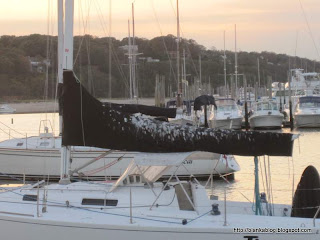I guess I was too long on land having spent almost two weeks away from the boat. We had a few days of nasty weather and I had a few things to take care of. As I drove toward the harbor and checked the waters of Long Island Sound. Conditions looked just delightful for a nice fall afternoon sail. But it was not to be. The harbor at this time of year starts to empty out as many owners have their boats pulled in preparation of winter:
The problem is that means less and less boats for birds like the Cormorants to roost upon. BIANKA which has no spreaders does not normally make an inviting target to land upon except when there are few other options. So when I got on board I was greeted by this wonderful mess on deck:
At least my boat was not the only one singled out by the messy birds:
To make matters worse I found that the pennant line of the mooring next to me was wrapped around my rudder causing BIANKA to lay abnormally to the wind and current.
In addition the Plexiglass glass top cover that was part of my new and improved solar Bimini was in pieces in the cockpit! LESSON LEARNED: I should have used Lexan.
So instead of the nice afternoon sail I spent it scrubbing the deck. Luckily, BIANKA has a wash down pump so I could wet down the deck and use some full strength Simple Green to help clean the sail cover and deck. But, I finished in time to sit back and enjoy the setting sun behind the western hill of the harbor:
and then the rising of the Harvest moon to the east as well:
Both of which made me glad to be on board and forget about the mess that greeted me when I first arrived..



































.jpg)




